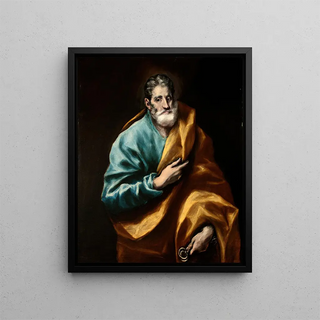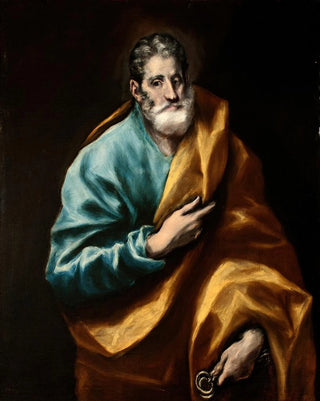Painting Apostle Saint Peter - El Greco | Art print


View from behind

Frame (optional)
Apôtre Saint Pierre - El Greco – Captivating Introduction
The work "Saint Peter the Apostle" by the Spanish master El Greco unfolds as a true ode to spirituality and human depth. Painted at the end of the 16th century, this iconic piece embodies the perfect fusion of mysticism and the pictorial technique of the era. Gazing at this painting, the viewer is instantly transported to a world where light and shadow dance across the canvas, revealing the intense emotions that inhabit the central figure. Saint Peter, with his penetrating gaze and expressive posture, seems to communicate timeless wisdom, inviting each person to reflect on their own spirituality and relationship with faith.
Style and uniqueness of the work
El Greco, whose real name is Domenikos Theotokopoulos, is distinguished by an inimitable style that combines elements of the Italian Renaissance with Baroque sensibility. In "Saint Peter the Apostle," vivid colors and elongated forms testify to his pursuit of transcendental expression. The face of Saint Peter, imbued with serenity and strength, is highlighted by a subtle play of light that accentuates his facial features and the richness of his garments. The draperies, often considered a signature of the artist, are rendered with a fluidity that seems almost tangible. This piece, through its chromatic intensity and bold composition, perfectly illustrates El Greco's ability to capture the very essence of his subjects, transcending a simple portrait to offer a true spiritual experience.
The artist and his influence
Born in Crete, El Greco managed to establish himself as an essential figure in European art. His journey took him from Greece to Venice, then to Toledo, where he developed a unique style that would influence generations of artists. His way of depicting human figures, often distorted and dramatic, paved the way for new artistic explorations. Byzantine influences, combined with an innovative approach to color and light, make him a precursor of Cubism and Expressionism. El Greco's impact is felt far beyond his time, inspiring artists such as Picasso and

Matte finish

View from behind

Frame (optional)
Apôtre Saint Pierre - El Greco – Captivating Introduction
The work "Saint Peter the Apostle" by the Spanish master El Greco unfolds as a true ode to spirituality and human depth. Painted at the end of the 16th century, this iconic piece embodies the perfect fusion of mysticism and the pictorial technique of the era. Gazing at this painting, the viewer is instantly transported to a world where light and shadow dance across the canvas, revealing the intense emotions that inhabit the central figure. Saint Peter, with his penetrating gaze and expressive posture, seems to communicate timeless wisdom, inviting each person to reflect on their own spirituality and relationship with faith.
Style and uniqueness of the work
El Greco, whose real name is Domenikos Theotokopoulos, is distinguished by an inimitable style that combines elements of the Italian Renaissance with Baroque sensibility. In "Saint Peter the Apostle," vivid colors and elongated forms testify to his pursuit of transcendental expression. The face of Saint Peter, imbued with serenity and strength, is highlighted by a subtle play of light that accentuates his facial features and the richness of his garments. The draperies, often considered a signature of the artist, are rendered with a fluidity that seems almost tangible. This piece, through its chromatic intensity and bold composition, perfectly illustrates El Greco's ability to capture the very essence of his subjects, transcending a simple portrait to offer a true spiritual experience.
The artist and his influence
Born in Crete, El Greco managed to establish himself as an essential figure in European art. His journey took him from Greece to Venice, then to Toledo, where he developed a unique style that would influence generations of artists. His way of depicting human figures, often distorted and dramatic, paved the way for new artistic explorations. Byzantine influences, combined with an innovative approach to color and light, make him a precursor of Cubism and Expressionism. El Greco's impact is felt far beyond his time, inspiring artists such as Picasso and
12,34 €






